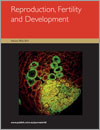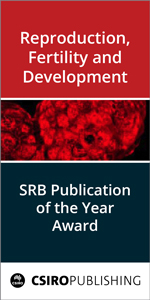Reproduction, Fertility and Development
Volume 29
Number 3 2017
Given the great potential of extracellular vesicles as biomarkers for detecting early-stage disease – in particular pre-eclampsia – here we have reviewed the characteristics of placenta-shed vesicles and conducted a meta analysis of their protein content, which has revealed significant variability. Achieving the goal of biomarkers for pregnancy disorders will depend on rigorous standards for isolation and detection of placenta-derived vesicles.
Over the last decade important advances have been made in the area of ovarian function using color-Doppler ultrasonography. Herein we investigated the influence of dimensions and vascularity of the preovulatory follicle (POF) wall as indicators to predict the size, blood flow, and capacity of progesterone production of the subsequent CL in cows. Strong correlations and linear associations between POF and/or CL dimensions and blood flow with systemic progesterone concentrations from the resultant CL were observed. Selection of POFs with greater blood flow is likely to result in CLs with improved potential for plasma progesterone production.
Comparing placental development of bovine embryos produced naturally, by IVF and by cloning would allow for improvements in animal production using assisted reproductive techniques. The present study demonstrates that gene expression of the imprinted gene pleckstrin homology-like domain, family A, member 2 (PHLDA2) is higher in early stage cloned placentas. This increase in PHLDA2 mRNA is associated with changes in the epigenetic event of histone methylation.
The induction of synchronous ovulation and determination of the time of insemination are critical steps for the success of timed AI (TAI) in dairy cattle. The addition of gonadotrophin-releasing hormone (GnRH) had no beneficial effect on tightening the time to ovulation when oestradiol cypionate was used, and similar pregnancy rates were achieved when AI was performed 48 or 54 h after device removal. Thus, inducing ovulation with oestradiol cypionate removes the need for GnRH and can be a cost-effective and flexible option for TAI in dairy herds.
To date, not much is known about the interaction of progesterone and LH, nor progesterone’s metabolism during early pregnancy in the sow. This study of the release pattern and concentration of progesterone in the caudal vena cava, following LH pulses revealed their temporary relation and confirmed postprandial decrease of progesterone. Already on day 14 of an individual sow’s second pregnancy, the function of the CL seems to be affected by LH.
Prostaglandins are important factors in mediating fertilisation and establishing pregnancy. In this study we investigate the effect of oestrogen on prostaglandin E2 (PGE2) and prostaglandin F2α (PGF2α) secretion and the role of synthase on PGE2 and PGF2a production in bovine oviduct epithelial cells. The findings suggest that exogenous oestradiol, PGE2 and PGF2α may modify bovine oviduct reproductive endocrine dysfunction.
Earlier studies have shown that in vitro supplementation of DHA produced inconsistent results on the quality of frozen–thawed bull semen. This work aimed to overcome the variations reported previously. Results showed that 3 ng mL–1 DHA supplemented in BioXcell extender improved all sperm parameters compared with the control and other groups. The successful incorporation of DHA into the cell membrane before freezing protected the spermatozoa from disintegration caused by ice crystals.
The cheetah population under human care is notoriously difficult to breed and scientists need to gather as much biological data as possible to overcome issues ranging from behavioural compatibility to infertility. This work found that male cheetahs managed in small, closely bonded groups experience increased testicular function, including higher sperm quality, compared to males housed singly. These findings support existing management practices to improve breeding efforts to build assurance populations of cheetahs.
Nucleolar precursor bodies (NPBs) are mandatory entities of mammalian zygotes, but their relation to nucleolus-like bodies (NLBs) of fully-grown oocytes remains vague. Here, we show that NPBs, unlike NLBs, are impoverished for RNA and rRNA despite of both bodies contain rRNA-binding proteins. We suggest a scheme for NPB assembly and transformation to functional nucleoli that supposes utilization of oocyte-derived nucleolar proteins but mainly of nascent rRNAs.
Regulation of c-kit during spermatogenesis remains largely unknown. Retinoic acid (RA) regulates c-kit expression through discrete promoter regions. An enhanceosome constituted between transcription factor binding sites RARE, PU.1 and ETS in response to RA play an imperative role in c-kit activation. RA-induced c-kit regulation may provide insights in the understanding of nuances between self renewal and differentiation of spermatogonial cells.
In cattle, sex steroids modulate pre-implantation uterine function, embryo receptivity and consequently, fertility. Prostaglandins (PGs) are synthesised in the endometrium and influence conceptus growth and corpus luteum lifespan. Here, we examined the biosynthetic pathway of PGs and determined that distinctly different pro-oestrus concentrations of oestradiol and dioestrus concentrations of progesterone did not affect endometrial PG production during the first week after oestrus. The influence of PGs in fertility occurs at later time points of gestation.
Eggs are used in mammals for experiments and fertility treatment, but new ways to determine their quality are still needed. Using the pig as a model, eggs had their surrounding shell removed to visualise finer details in cell membranes during cleavage, showing new patterns reflecting their normality or otherwise. These observations supplement traditional egg evaluations, but require validation in other types of embryos from other mammals.
Can paternal experiences be transmitted to offspring? Here we show that mating of immunised male mice with unimmunised females significantly altered gestation conditions and in utero embryo development resulting in increased embryonic bodyweight. These results emphasise that, as active environmental explorers, males confer their experiences to their progeny, suggesting an important mechanism of population-wise adaptation to infectious load.
C-type natriuretic peptide (CNP) may be required for support of the developing conceptus during pregnancy. We explored this by placing pregnant ewes on a restricted diet and found that their blood levels of CNP were elevated in comparison with ewes on a normal level of nutrition. Elevation of CNP levels may be an adaptation to enhance placental function when fetal development is impaired.
Our study evaluated how the stria vascularis and organ of Corti develop in miniature pigs. The stria vascularis develops during the embryonic period, concurrent with maturation of the organ of Corti in miniature pigs. The magnitude of endocochlear potential reached a steady state when the stria vascularis was morphologically adult-like at E98. These findings provide a morphological and functional basis for future animal studies of various inner-ear diseases.
Spix’s yellow-toothed cavies (Galea spixii) are hystricomorph rodents. The ovarian preantral follicle (PF) population of G. spixii was characterised in the present study. It was estimated that the PF population per ovarian pair was 416.0 ± 342.8 (mean ± s.e.m.). Moreover, after a solid surface vitrification process using dimethyl sulfoxide as the cryoprotectant, 69.5% of PFs were morphologically normal.
The role of thyroid hormones in implantation and early embryo development has been highlighted recently because of the increased use of assisted reproduction technology (ART). Close examination of thyroid function in women undergoing ovarian stimulation shows that thyrotropin-stimulating hormone (TSH) concentrations could increase during the procedure, particularly in women who become pregnant. If this is true, special care, such as universal baseline screening, has to be considered for women undergoing ART.
Testicular cancer is the most common malignancy among young men; however, the mechanisms driving tumour growth are unclear. Herein we show that Sertoli cell tumours in the adult mouse testis can be profoundly suppressed by short-term inhibition of the pituitary hormone FSH in early postnatal life. These results show that FSH protects against Sertoli cell tumour growth during discrete windows of testicular development.
The post-fertilisation culture environment in vitro determines embryo quality, and different strategies have been developed to improve culture conditions. The use of bovine oviductal fluid supplementation during in vitro culture had a positive effect on embryo development and embryo quality. Thus, by mimicking in vivo conditions using animal models, we could improve assisted reproductive technologies applied to both domestic species and humans.
It is now possible to reliably collect crocodile semen for fertility evaluation and AI. Herein we describe a validated method for assessing the quality of crocodile sperm DNA using the sperm chromatin dispersion test. This technique, a first for any reptile, will now be used for refining improved methods of crocodile sperm preservation.




